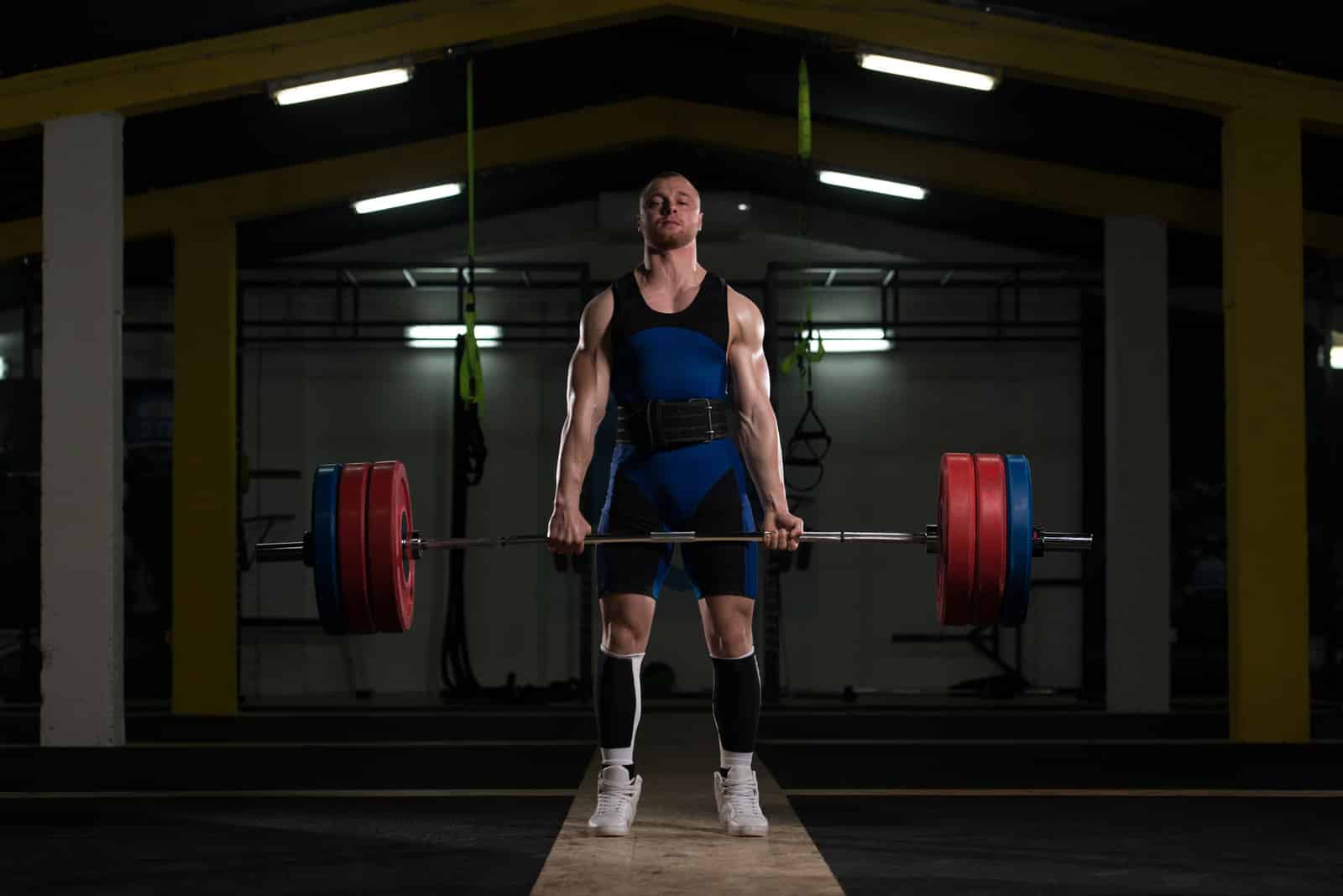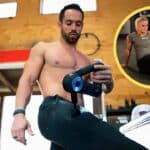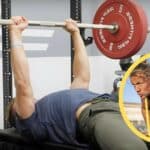So, you’re looking for Romanian deadlift alternatives? Whether traveling, recovering from injury, or seeking variety, substitutions can be valuable tools in your arsenal. Several options target the hamstrings, glutes, and Posterior Chain.
Let’s look at some of the best RDL substitutions, regardless of whether you have a barbell, cable machine, dumbbells, or nothing.
There are several Romanian deadlift substitutes you can add to your workout routine, regardless of your fitness goals. Using alternative movements can help target different muscles, adding variety, and adjusting the load. Let’s look at various RDL substitutes, depending on your situation and fitness goals.
Jump to:
- 11 Best RDL Alternatives:
- Romanian Deadlift Alternatives If You Have a Barbell Available
- 1. Straight Leg Deadlift
- 2. Trap Bar Deadlift
- 3. Barbell Hip Thrust
- 4. Good Mornings
- Dumbbell Variations to Consider
- 5. Dumbbell Romanian Deadlift
- 6. Single-Leg Romanian Deadlift
- 7. Kettlebell Swings
- Cable and Bodyweight Variations
- 8. Standing Cable Pull Through
- 9. Pistol Squat
- 10. Floor-Lying Glute Ham Raise
- 11. Glute bridge
- Frequently Asked Questions (FAQ)
11 Best RDL Alternatives:
- Straight Leg Deadlift
- Trap Bar Deadlift
- Barbell Hip Thrust
- Good Mornings
- Dumbbell Romanian Deadlift
- Single-Leg Romanian Deadlift
- Kettlebell Swings
- Standing Cable Pull Through
- Pistol Squat
- Floor-Lying Glute Ham Raise
- Glute bridge
Prefer video? Here’s one we did specifically for this article:
Romanian Deadlift Alternatives If You Have a Barbell Available
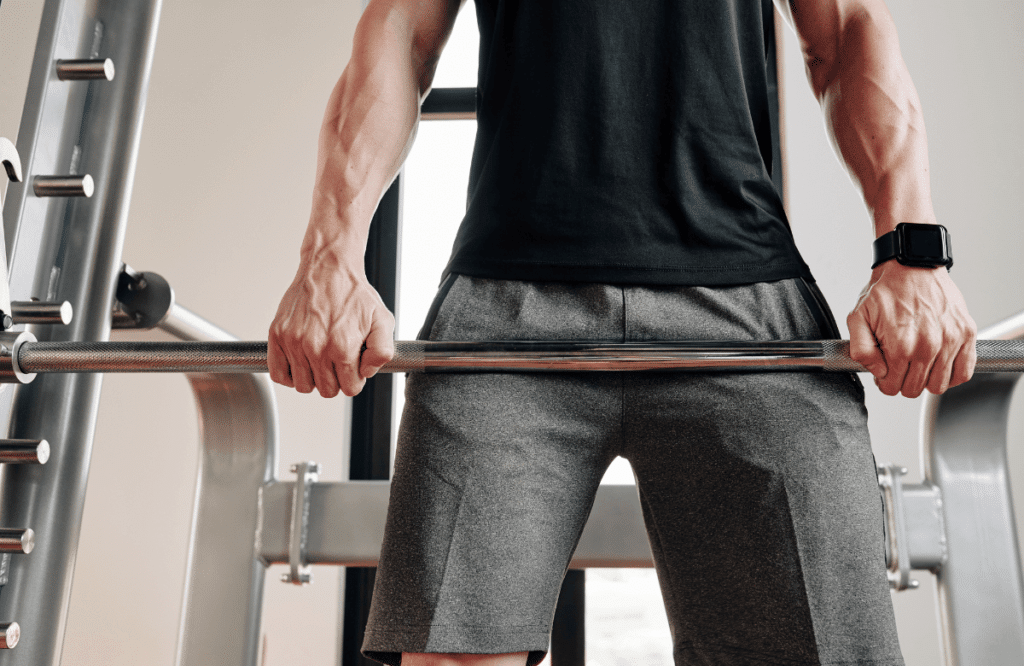
Whether at your home gym or local fitness center, there are several Romanian deadlift variations you can try if you have a barbell on hand. Many of these movements target similar muscles, like the hamstrings and glutes. Here are a few to keep in mind.
1. Straight Leg Deadlift
The stiff leg deadlift is often mistaken for the Romanian deadlift as the movement pattern looks similar. Both exercises are hip hinge movements and activate identical muscle groups.
The stiff-leg deadlift touches the ground, while the Romanian variation doesn’t. Furthermore, the straight-leg deadlift emphasizes the hamstrings, while the Romanian deadlift hits the glutes more.
How to Perform
- Place the barbell on the ground in front of you. Step up to the bar and stop when it’s over the middle of your foot. Your feet should be shoulder-width apart.
- Take a deep breath and lean forward to grip the bar. Ensure there’s only a slight bend in your knees, and maintain a tight back.
- Without exhaling, tighten your core, and lift the barbell.
- Pull the bar up your body. Maintain a straight back until you’re in a standing position.
- Now, slowly lower the barbell toward the ground while keeping your legs straight.
- Take another inhale and repeat the movement for additional reps.
Benefits
- Targets major muscles in the Posterior Chain, like the hamstrings, glutes, and calves.
- Enhances functional strength for daily activities, like bending over and picking things up.
- Adds crossover training to the conventional deadlift.
- Very similar to the Romanian Deadlift.
- Makes a great isolation exercise.
2. Trap Bar Deadlift
The hex bar deadlift is an interesting Romanian deadlift substitute. The movement can be effective at targeting similar muscle groups if you have access to a trap bar. That said, this movement will place more emphasis on the quads instead of the glute and hamstring muscles.
How to Perform
- Step into the center of the hex bar. Keep your feet shoulder-width distance.
- Hinge at the hips so that your glutes go backward. Next, slightly bend the knees and grasp the bar. Maintain a neutral spine and keep your chest high.
- Keep a neutral grip with your palms facing toward you.
- Push through your feet and lift upward. Do not move your knees.
- Once you’re almost standing completely straight, unbend your knees. The load should be in front of the thighs.
- Lower the trap bar using the same pattern and repeat for reps.
Benefits
- Easy to learn for new lifters.
- Targets muscles in the posterior chain.
- Compound exercise.
- Places less strain on the lower back.
- You can use heavier weights.
- Won’t scrape the shins like traditional barbells.
- Activates the quads more.
3. Barbell Hip Thrust
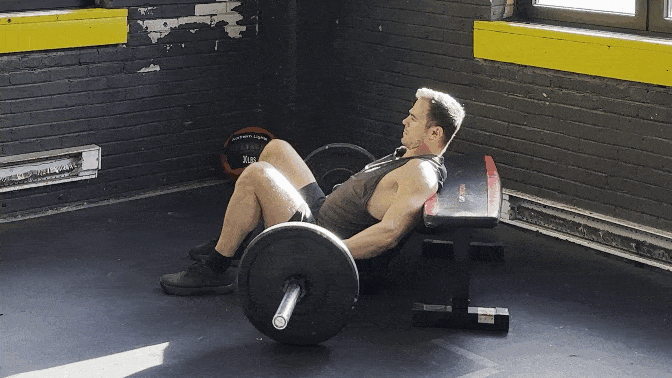
The barbell hip thrust hits the glutes and hamstrings just like the Romanian deadlift but doesn’t use much of the lower back. It’s a straightforward movement that works well as a Romanian deadlift substitution.
How to Perform
- Rest your upper back on a bench and place the barbell on the crease of your hips.
- Keep your feet a bit wider than shoulder-width distance and the toes flared.
- Push your feet into the ground and lift at the hips.
- Tighten your glutes for the full extension and move your pelvis underneath you at the top of the move.
- Your upper back and shoulders will push into the bench. Keep the chin tucked.
- Lower your body and repeat the pattern for reps.
Benefits
- Easy to learn for beginners.
- Easy starting position.
- Can increase Posterior Chain muscles
- Places less strain on the lower back.
- Enhances hip extension strength.
- Excellent at targeting the glutes and hamstrings.
- Improves functional movements.
4. Good Mornings
Good mornings work well as a Romanian deadlift substitute and will target more of the low and mid-back muscles. That said, good mornings aren’t suited for beginners, as it requires proper hip-hinge technique and a neutral spine. Using too much weight with the good morning has a high chance of injury.
The good-morning is definitely worth a shot if you’re comfortable under the barbell and have experience with the squat or deadlift.
How to Perform
- Take an athletic starting position with your feet shoulder-width apart. Grip the barbell on your back as you would for a back squat.
- Pull your shoulders back. Maintain a wide, upright chest and hinge your hips toward the wall behind you.
- Maintain a flat back as you hinge at the hips. You should feel a stretch in your hamstrings as you execute the technique.
- Keep your core tight and pull yourself back to the starting stance to finish the rep.
Benefits
- Targets primary movers in the Posterior Chain.
- Excellent at activating more of the low and mid-back muscles.
- Very similar to the Romanian Deadlift.
- More complex barbell movement.
Dumbbell Variations to Consider
Dumbbell variations are helpful when you’re learning a new technique, recovering from an injury, adding accessory movements, or when you don’t have a barbell available.
Lifting as heavy with dumbbells is impossible, but you can move the weight more freely and develop more stability and body awareness. Here are some of the best dumbbell variations for the Romanian deadlift.
5. Dumbbell Romanian Deadlift
As you can imagine, the Romanian dumbbell deadlift is the closest substitution to the real thing. The movement is identical and will target your hamstrings and glutes.
The dumbbell variation can be incorporated as a warm-up, to improve hip-hinge technique or as a Romanian deadlift substitute. Try programming the dumbbell variation on intense leg days where you need additional work that doesn’t require as much effort.
How to Perform
- Grip dumbbells in each hand. Keep your hands in front of and just outside of your thighs.
- Now, bend at the knees and hinge forward with your hips. Do not allow your knees to bend further.
- Lower the weight to underneath the knee and push your hips as far back as you can.
- Keep the back neutral. The shoulders should be in front of the dumbbells at the bottom portion of the lift.
- Lastly, tighten your glutes to return to the starting stance. Repeat the pattern for reps.
Benefits
- The closest alternative to the barbell Romanian deadlift.
- Targets the hamstrings and glutes.
- It can be used as a warm-up, to improve technique, or as a replacement.
- Ideal for low-intensity workout sessions.
- You can use less weight.
- A similar range of motion.
- It can use higher rep range compared to other lifts.
6. Single-Leg Romanian Deadlift
The single-leg Romanian deadlift is a unilateral variation that targets the right and left muscles independently. Unilateral movements can help improve muscle imbalances, improve balance, enhance recovery, and prevent overtraining.
Your hips, glutes, and core work in tandem to help you balance and stay upright, making the single-leg Romanian dumbbell deadlift a fantastic functional exercise. It can improve athletic skills like running, leaping, and bending over.
How to Perform
- Grip a dumbbell in each hand. Gently bend the right leg while maintaining square hips.
- Move the left leg back as you bend forward. Maintain a tight back.
- The hips should be stable on the ground.
- Allow the dumbbells to hang in front of your body with your arms forward.
- Once your back is parallel to the ground, squeeze your right glute to bring the body to a standing position.
- Repeat the pattern on each leg for reps.
Benefits
- A unilateral variation that targets muscles independently.
- Can help improve muscle imbalances and stability.
- It may help enhance recovery and reduce overexertion.
- You can lighter weights.
7. Kettlebell Swings
Kettlebell or dumbbell swings might look completely different, but they use similar muscles to the Romanian deadlift. The kettlebell swing uses similar hip-hinge movements alongside the glutes, hamstrings, spinal erectors, and more.
It’s a full-body exercise that can be performed to develop the posterior Chain and burn extra calories. It’s a great move if you’re seeking variety, want to burn fat, or need full-body movement.
How to Perform
- Set a kettlebell on the floor in front of you.
- Hinge at your hips to bend over gently. Grip the kettlebell handles with both hands.
- Bring the kettlebell backward between the legs. Push your hips forward and use the force to bring the weight to chest height. Maintain a straight back.
- Allow the weight to come back down and hinge at your hips. Let it move between the legs.
- Repeat the pattern for reps.
Benefits
- Full body exercise
- High intensity
- You can use lighter loads.
- Excellent for burning calories
- Targets the glutes, hamstrings, and spinal erectors.
- It can be easy to learn.
- It makes a great cardio workout.
Cable and Bodyweight Variations
If you don’t have access to barbells or dumbbells, you can always use cables or bodyweight exercises.
These movements can be excellent for beginners, intermediates, and advanced lifters. You can use them in place of the Romanian deadlift if you need a low-intensity day, don’t have any equipment, or want to focus on the mind-body connection.
8. Standing Cable Pull Through
Standing cable pull-throughs are a brilliant exercise, as they prioritize the glutes and hamstrings like the RDL. The difference is that you can maintain constant tension during the training. This movement also uses the cable pulley machine.
Don’t be discouraged by how the weight exercise looks. It may seem awkward to have a cable pulley between your legs, but it’s a worthy movement to program into your routine.
How to Perform
- Secure a rope attachment to the bottom of a cable machine.
- Grab the rope attachment with both hands between the legs. Turn away from the cable machine.
- Take 1-3 steps forward and take an athletic stance with your feet a bit wider than shoulder-width.
- Keep a slight bend in your knees and hinge forward at your hips.
- The rope will move between the legs with a neutral spine.
- Once your back is parallel to the ground, tighten your glutes to return to the starting stance.
- Repeat the pattern for reps.
Benefits
- Muscles have a longer time under tension.
- Emphasizes the glutes and hamstrings.
- It can be easy to learn.
- It may reduce the risk of injury in daily activities, like bending over and squatting.
- Suitable for strength and endurance training.
9. Pistol Squat
The pistol squat is an excellent bodyweight exercise to try in place of the Romanian deadlift. It requires strength, power, balance, and flexibility. The unilateral movement can increase functional strength and targets each side of your body. It may be challenging for beginners, but it’s fantastic for developing the glutes, hamstrings, quads, and calves.
How to Perform
- You may need to stand next to a wall or similar object to stabilize yourself.
- Place your weight onto the right leg and lift your other leg in front of you.
- Now, squat down by hinging at the hips. Ensure the right knee doesn’t lose balance and the chest stays high.
- Lower down as far as possible or until the thighs are parallel to the floor.
- Push through your foot to return to the starting stance.
- Repeat the pattern for reps.
Benefits
- Doesn’t require any weights. Body weight is challenging enough.
- Excellent for improving power, balance, strength, and flexibility.
- Increases functional body strength.
- Reduces the chance of injury in daily activities.
- Target muscles like the glutes, calves, and hamstrings.
10. Floor-Lying Glute Ham Raise
You don’t need any equipment for the floor-lying glute ham raise, which makes it an ideal substitution for the RDL. It challenges the hamstrings and glutes just like the Romanian deadlift, but you might need a partner. Have a partner grip your ankles as you lower your torso toward the ground.
The tricky part is maintaining tension and control as you descend. It’s best to go slowly to get the most benefits. There are glute ham raise machines available, and your gym might have one, so look around to be sure.
How to Perform
- Kneel on the ground with the legs shoulder distance apart. Keep your torso upright.
- Press the ball of your foot into the ground.
- Have a friend place pressure on the back of your ankles.
- Now, keep the hands outside of your shoulders with your palms open.
- Slowly lower yourself to the floor without breaking at the hips. The slower, the better.
- Once the tension becomes too high, move into a push-up stance.
- Push yourself back up to the starting stance and repeat for reps.
Benefits
- Doesn’t require any equipment.
- Targets the hamstrings and glutes.
- Maintains muscle tension throughout the movement.
- Easy to learn.
- It may improve balance, stability, and core strength.
11. Glute bridge
The glute bridge is essentially the barbell hip thrust without the barbell. It’s a beginner-friendly exercise that has a decreased range of motion, making it easy to execute. It can be done anywhere you can lay on the floor and targets the glutes efficiently.
How to Perform
- Lie on your back. Keep the knees bent with your feet flat on the ground. Your arms will remain at your sides.
- Take a deep breath and push through your feet. Tighten your core, glutes, and hamstrings. Lift your hips toward the sky.
- Take a pause at the top of the movement. Slowly lower yourself to the starting position.
- Repeat the pattern for reps.
Benefits
- Doesn’t require any weights.
- Incredibly easy to learn.
- Targets similar muscles as the RDL
- A more accessible version of the barbell hip thrust.
- It can be performed anywhere.
Frequently Asked Questions (FAQ)
Are Romanian Deadlifts Necessary?
Romanian deadlifts can be an effective movement for increasing hip mobility, activating the glutes, and enhancing muscle strength. The Romanian deadlift has advantages for functional tasks, like bending down or squatting. That said, movements like the stiff leg deadlift or the barbell hip thrust can be good alternatives.
Can I Substitute RDL For the Conventional Deadlift?
Yes, it’s possible to substitute the RDL for the deadlift, as they train similar muscle groups. That said, the deadlift has a broader range of motion and activates more muscle groups. The Romanian deadlift is better for isolating the hamstrings and glutes.



